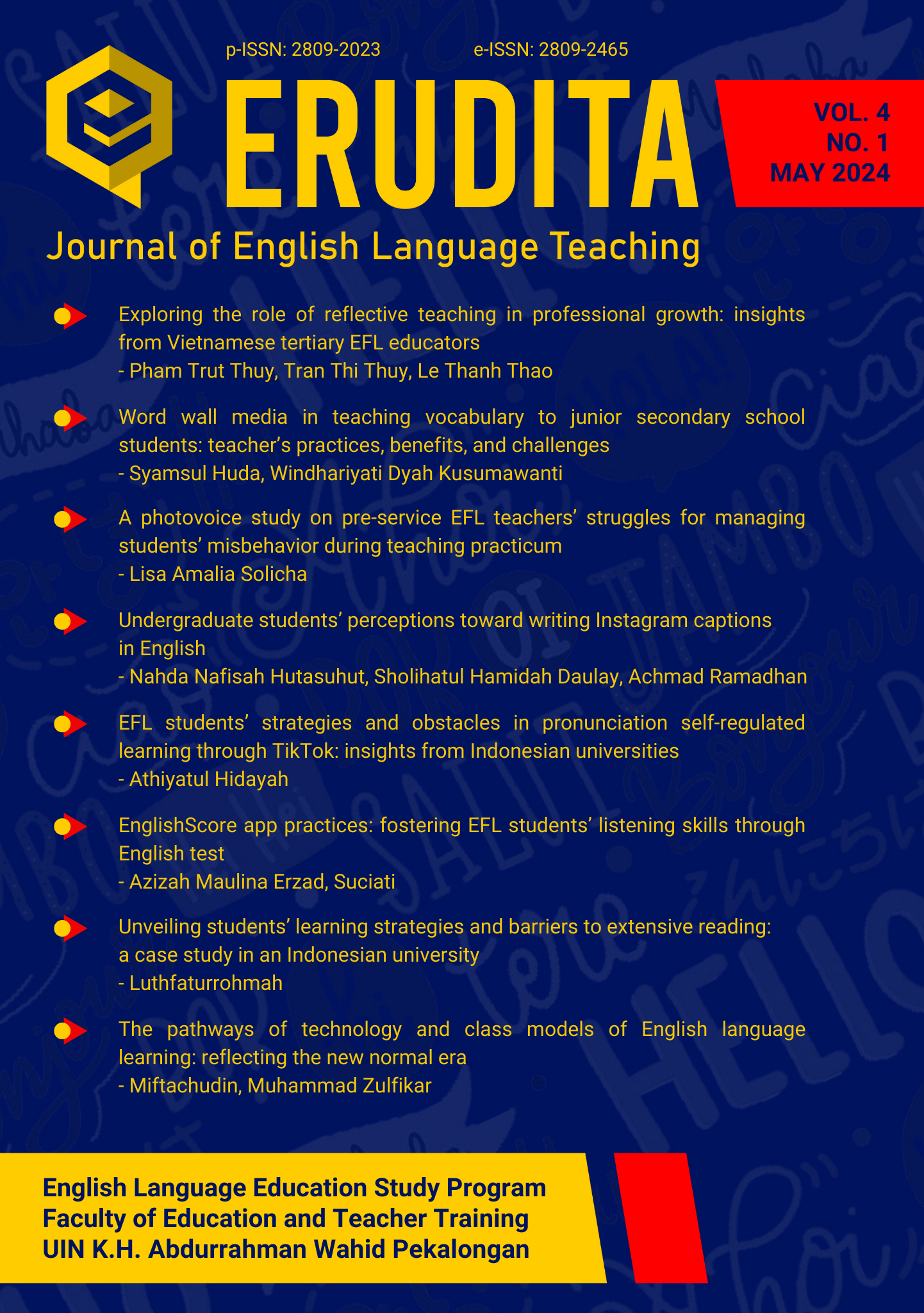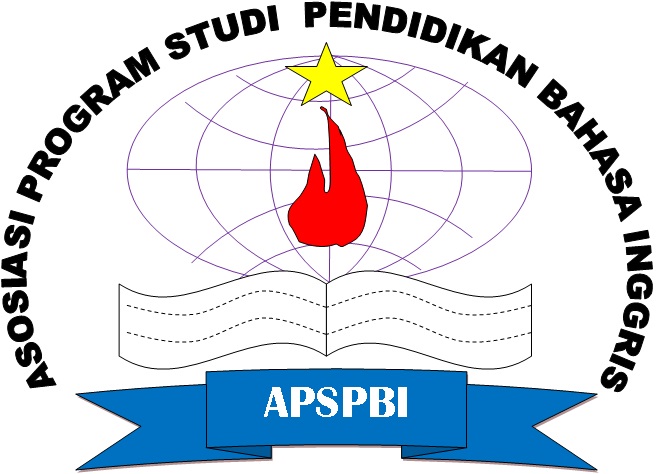The pathways of technology and class models of English language learning: reflecting the new normal era
DOI:
https://doi.org/10.28918/erudita.v4i1.8528Keywords:
Class models, Distance learning, EFL learning, New normal era, Post-COVID-19, Technology useAbstract
This research aims to showcase English language learning in the new normal era from 17 May 2022 to 30 June 2023. It focuses on conditions, class models, the reasons for class model adjustment, and the role of technology. Using an open-ended questionnaire, the researchers obtained information about the phenomenon and complete data from 83 teachers in Salatiga and Semarang Regency, Central Java, Indonesia. The study findings demonstrate that the conditions of English language learning in the new normal era coped with learning adaptation, challenging learning, learning improvement, changes in character, the amusement of face-to-face classes, and low understanding of the material. Regarding class models, during two years of the pandemic, teachers predominantly used offline, blended, hybrid, and online class models. The main reasons for the adjustment in the class models were the need for social interaction, knowledge development, behavioral education, and health factors. Regarding technology’s contributions, it was crucial to develop learning materials. This study concludes with empirical insights into consideration for further development of English language learning by integrating technology and various class models so that teachers can mitigate and sustain learning due to probable extenuating circumstances in the future.
References
Bao, W. (2020). COVID-19 and online teaching in higher education: A case study of Peking University. Human Behavior and Emerging Technologies, 2(2), 113–115. https://doi.org/10.1002/hbe2.191
Bergmann, J., & Sams, A. (2012). Flip your classroom: Reach every student in every class every day. International Society for Technology in Education.
Bogdan, R., DeVault, M. L. & Taylor, S. J. (2016). Introduction to qualitative research methods (4th ed.). John Wiley & Sons.
Bozkurt, A., Jung, I., Xiao, J., Vladimirschi, V., Schuwer, R., Egorov, G., Lambert, S. R., Al-Freih, M., Pete, J., Olcott Jr, D., & Rodes, V. (2020). A global outlook to the interruption of education due to COVID-19 pandemic: Navigating in a time of uncertainty and crisis. Asian Journal of Distance Education, 15(1), 1–126. https://www.asianjde.com/ojs/index.php/AsianJDE/article/view/462
Creswell, J. W. (2008). Educational research: Planning, conducting, and evaluating quantitative and qualitative research. Pearson.
Creswell, J. W., & Creswell, J. D. (2018). Research design: Qualitative, quantitative, and mixed methods approaches (5th ed.). SAGE Publications, Inc.
Dhawan, S. (2020). Online learning: A panacea in the time of COVID-19 Crisis. Journal of Educational Technology Systems, 49(1), 5–22. https://doi.org/10.1177/0047239520934018
Deng, S. J., & Li, B. (2023). Research on the evolution path of 5G technology from the perspective of social network analysis: Based on the analysis of China and the United States patent citations. Technology Analysis & Strategic Management, 1–16. https://doi.org/10.1080/09537325.2022.2162875
Farrah, M., & Zalloum, I. O. (2022). EFL teachers’ attitudes towards online learning in Palestinian high schools during the COVID-19 pandemic. Erudita: Journal of English Language Teaching, 2(2), 94–114. https://doi.org/10.28918/erudita.v2i2.6084
Fitria, T. N. (2020). Teaching English through online learning system during COVID-19 pandemic. Pedagogy: Journal of English Language Teaching, 8(2), 138–148. https://doi.org/10.32332/pedagogy.v8i2.2266
Garrison, D. R., & Kanuka, H. (2020). Blended learning: Uncovering its transformative potential in higher education. The Internet and Higher Education, 7(2), 95–105. https://doi.org/10.1016/j.iheduc.2004.02.001
Ghufron, M. A. (2021). The implementation of EFL online learning: How do the non-English department students perceive it? Erudita: Journal of English Language Teaching, 1(1), 28–38. https://doi.org/10.28918/erudita.v1i1.4451
Gligorea, I., Cioca, M., Oancea, R., Gorski, A.-T., & Gorski, H. (2023). Adaptive learning using artificial intelligence in e-learning: A literature review. Education Sciences, 13(12), 1–27, https://doi.org/10.3390/educsci13121216
Hadfield, A. (2022). From pandemic to endemic? Learning lessons from a global contagion. Journal of Chinese Economic and Business Studies, 20(3), 225–233. https://doi.org/10.1080/14765284.2021.2024486
Kennedy, D., & Duffy, T. (2004). Collaboration—a key principle in distance education. Open Learning: The Journal of Open, Distance and e-Learning, 19(2), 203–211. https://doi.org/10.1080/0268051042000224798
Khasanah, D. R. A. U., Pramudibyanto, H., & Widuroyekti, B. (2020). Pendidikan dalam masa pandemi Covid-19 [Education in the time of COVID-19 pandemic]. Jurnal Sinestesia, 10(1), 41–48. https://sinestesia.pustaka.my.id/journal/article/view/44
Kim, S., Byun, J., & Thomson, J. R. C. (2021). Adapting to a new normal: The impact of COVID-19 on the mediatization of professional sport organizations. Sport in Society, 25(7), 1307–1326. https://doi.org/10.1080/17430437.2021.2017888
Means, B., Toyama, Y., Murphy, R., Bakia, M., & Jones, K. (2020). Evaluation of evidence-based practices in online learning: A meta-analysis and review of online learning studies. U.S. Department of Education.
Moorhouse, B. L., & Wong, K. M. (2022). Blending asynchronous and synchronous digital technologies and instructional approaches to facilitate remote learning. Journal of Computer Education, 9, 51–70. https://doi.org/10.1007/s40692-021-00195-8
Muhyiddin. (2020). COVID-19, new normal, dan perencanaan pembangunan di Indonesia [COVID-19, new normal, and development planning in Indonesia]. The Indonesian Journal of Development Planning, 4(2), 240–252. https://doi.org/10.36574/jpp.v4i2.118
Murphy, M. P. A. (2020). COVID-19 and emergency eLearning: Consequences of the securitization of higher education for post-pandemic pedagogy. Contemporary Security Policy, 41(3), 492–505. https://doi.org/10.1080/13523260.2020.1761749
Pekrun, R., Lichtenfeld, S., Marsh, H. W., Murayama, K., & Goetz, T. (2020). Achievement emotions and academic performance: Longitudinal models of reciprocal effects. Journal of Educational Psychology, 112(2), 382–397. https://doi.org/10.1111/cdev.12704
Putra, A. S. & Warnars, H. L. H. S (2019). Intelligent traffic monitoring system (ITMS) for smart city based on IoT monitoring. The 1st 2018 Indonesian Association for Pattern Recognition International Conference Proceedings, INAPR 2018 (pp. 161–165). INAPR. https://doi.org/10.1109/INAPR.2018.8626855
Rahmawati, I. (2016). Pelatihan dan pengembangan pendidikan jarak jauh berbasis digital class platform Edmodo [Training and development of distance education based on Edmodo digital class platform]. Prosiding Temu Ilmiah Nasional Guru (Ting) VIII (pp. 411–419). Universitas Terbuka. https://repository.ut.ac.id/6536/
Sun, A., & Chen, X. (2021). Online education and its effective practice: A research review. Journal of Information Technology Education: Research, 15, 157–190. https://doi.org/10.28945/3502
Traxler, J. (2018). Distance learning-predictions and possibilities. Education Sciences, 8(1), 35–48. https://doi.org/10.3390/educsci8010035
Valentino, V. H., Setiawan, H. S., Habibie, M. T., Ningsih, R., Katrina, D., & Putra, A.S. (2021). Online and offline learning comparison in the new normal era. International Journal of Educational Research & Social Sciences (IJERSC), 2(2), 449–455. https://doi.org/10.51601/ijersc.v2i2.73
Zhang, W., Wang, Y., Yang, L., & Wang, C. (2021). Suspending classes without stopping learning: China’s education emergency management policy in the COVID-19 outbreak. Journal of Risk Financial Management, 13(3), 39–54. https://doi.org/10.3390/jrfm13030055
Downloads
Published
How to Cite
Issue
Section
License
Copyright (c) 2024 Miftachudin, Muhammad Zulfikar

This work is licensed under a Creative Commons Attribution-ShareAlike 4.0 International License.















